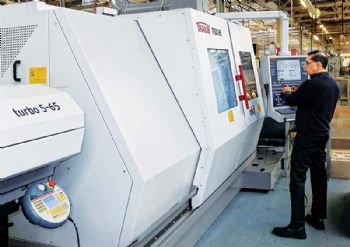
Liberty — part of GFG Alliance (a global industrial, metals and energy group) — recently announced its investment in
a £10 million global technology centre in Leamington Spa.
By the beginning of 2020, in time for the 100th anniversary of the start of automotive production at the site, all the design and manufacture of Liberty’s braking systems — currently in an adjacent plant — will be transferred to the modern facility, which will also become home to Liberty’s wider research, design and product development activities.
Among the advanced manufacturing equipment will be new CNC lathes, machining centres and other equipment worth £5 million bought since the acquisition of 920E (originally Automotive Products), including two Traub turning centres built in Germany and supplied through the Gosport-based UK, Ireland and Middle East agent Kingsbury (
www.kingsburyuk.com).
Installed in July and September 2018, they took the number of Traub turning machines on site to eight.
The first of the pair to arrive in Leamington was a 32mm bar-capacity TNL 32, which can be changed over quickly from sliding-head to fixed-head operation: the collet that feeds the bar through the guide bush is released, and the bar is clamped in a collet in the spindle, allowing the material to be moved into and out of the cutting zone using the Z-axis motion of the headstock.
Liberty’s production group leader Bill Dhesi says that, on average, they alternate once per month between the two methods of turning in order to optimise efficiency, as many parts are needed in low volumes.
The second machine was a TNX 65 — another twin-spindle twin-turret turn-mill lathe, but for fixed-head turning only. It can produce parts from bar up to 65mm in diameter.
Part programming
Both Traub lathes are controlled by the manufacturer’s System TX8i-s CNC system; and while simple jobs are programmed on the shopfloor, most are prepared offline using Traub’s WinFlex IPS Plus programming, optimisation and simulation software.
Mr Dhesi said: “The latest Traubs turn-mill parts more than 25% faster than the older machines, due to their higher spindle speeds, faster axis movements, quicker turret indexing and higher-power driven tooling.

“The advantage of the TNL 32 is that we use it in sliding-head mode for about 20% of the time to produce long slender parts such as pins, pushrods and plungers, which were previously either sub-contracted or turned in-house — less than optimally — on our fixed-head lathes.
“Likewise, the TNX 65 is also saving on external sub-contract manufacturing, as we could only turn up to 42mm bar before, and some of our component diameters are larger.
“It gives us greater control and shorter lead times — and saves us money.”
Many of these components find their way into brake systems, calipers and actuation products for marques such as JLR, Mini, Morgan and other major automotive brands.
They are supplied to production lines mainly in the UK and also to outlets for after-market sale.
In 2017, Liberty started making braking systems for a Formula One team, through its 920E and Shiftec brands; the company is currently expanding its overall involvement in the motor-sport sector.
Changing requirements
The earlier Traub fixed-head lathes were installed over a five-year period to 1998, and all but the first are still regularly used for production.
They were bought primarily to carry out second-operation work on parts coming off dozens of cam-type multi-spindle automatics.
Most of the multis have now been sold, as brake system component volumes have continued to fall with Liberty’s concentration on niche business contracts.
Any output now from the remaining multis does not require further operations, so the turn-mill centres are devoted to the one-hit production of simple to complex parts.
Most are mild steel, although aluminium, stainless steel and titanium are also processed.

Both of the latest Traub lathes can comfortably hold Liberty’s tightest dimensional tolerance, and nearly every part requires synchronous pick-up for back-end machining.
In conclusion, Mr Dhesi said: “We have not produced many components requiring extensive driven-tool operations within the cycle, but there are jobs coming along that will have up to 30% milling content.
“Obviously, standardising on one make of turning centre has its advantages in terms of spares commonality, familiarity with the control and being able to swap programs and tooling.
“That said, the Traubs were the clear front-runner for the latest purchases, not only due to the tight tolerances they hold but also because the high power offered by their live tooling will minimise cycle times for producing parts with a lot of prismatic-machining content.”